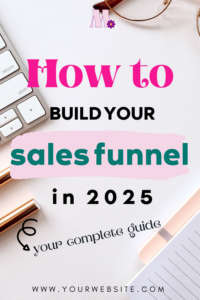I still remember the first time I woke up and realized I had gotten paid overnight—not from hustling or grinding, but from a sales funnel I’d set up months ago. That moment, seeing money come in while I slept, was the dream. And the best part? It’s something anyone can achieve with the right strategy.
So, what is a sales funnel in digital marketing? Simply put, it’s the step-by-step process that guides potential customers from discovering your business to making a purchase. Over the past decade, I’ve helped entrepreneurs set up these systems to scale their businesses without burning out. And here’s the truth: whether you realize it or not, you already have a sales funnel in place. The question is—does it work for you, or is it working against you?
In this guide, I’m breaking down everything you need to know about sales funnels. You’ll learn what they are, how they work, and how to create one that actually helps you make money while you sleep. Let’s dive in!
Oh, but by the way, one of the biggest questions I get is where you should build your sales funnel, and my go-to is Kajabi. It’s an all-in-one platform with all the bells and whistles while still being intuitive and easy to use. I am an affiliate for them because I personally use the platform for my own courses and funnels. If you want to try it out for 50% off, you can use my affiliate link.
What Is a Sales Funnel in Digital Marketing?
At its core, a sales funnel is just the journey your customers take from finding out about your business to making a purchase. It’s not some mystical, over-complicated process—it’s simply a way to guide people toward becoming your customers in a way that makes sense and works efficiently.
Think of it this way: if you’re selling anything, you already have a funnel. It might be as simple as chatting in DMs with people and manually closing sales, but that’s still a funnel. The goal, though, is to create a funnel that’s productive, passive, and automated, so you’re not stuck in the DMs all day hustling for every sale.
A good sales funnel isn’t just about making money. It’s about giving you freedom—freedom to take a vacation, enjoy your weekends, and actually live your life while your business continues to run. That’s why you wanna learn what is a sales funnel in digital marketing.
Why Sales Funnels Still Matter in 2025
You might have heard people saying sales funnels are outdated or unnecessary, but let me be real with you: that advice is trash. Look at any major business, influencer, or entrepreneur—they all have some form of a sales funnel. Why? Because they work.
Without a sales funnel, you’re left doing everything manually. You’re stuck in a cycle of one-on-one conversations, constantly hustling to make sales. That’s not sustainable. With a well-designed funnel, you can scale your business, automate your processes, and finally get some breathing room.
Here’s the thing: sales funnels aren’t just about automation. They’re about creating a system that works for you instead of against you. The key is to make the journey from awareness to purchase as seamless as possible for your customers while making your life easier in the process.
The Key Components of a Sales Funnel
To build a sales funnel that works, you need to understand its basic components. These aren’t complicated—they’re just the steps that take someone from being a stranger to a loyal customer.
The first step is a lead magnet. This is some kind of free offer or low-cost product that gets people into your world. Think about when you visit a website, and they offer you 10% off your first order if you sign up for their email list. That’s a lead magnet. For service-based businesses, it might be a free ebook, a checklist, or even a mini-course. The idea is to give people a reason to connect with you and join your email list.
Then there’s the thank-you page. This is a hugely underutilized part of most sales funnels. Instead of just saying “thanks for signing up,” use this page to give people something extra—a quick tip, a bonus resource, or even a low-ticket offer related to your lead magnet. This small step can make a big difference in how connected people feel to your brand.
Once someone opts in, they move into your email sequence. This is where the magic happens. You’re building trust, nurturing the relationship, and introducing them to what you have to offer. The goal here isn’t just to sell; it’s to create a connection. The better your emails, the more likely people are to stick around and eventually buy from you.
Finally, you’ve got the sales page. This is where you pitch your main offer. A good sales page answers objections, highlights the transformation your product or service provides, and makes it easy for people to say yes. Don’t overcomplicate it—your job is to guide them to the decision that’s right for them.

How to Build a Sales Funnel Step-by-Step
Start with the end in mind. Before you even think about creating a lead magnet or email sequence, you need to know what you’re selling and who you’re selling it to. Everything in your funnel should align with your offer, so your lead magnet, emails, and sales page all lead naturally to the same place.
Next, create your lead magnet. Don’t overthink this step. Your lead magnet doesn’t need to be perfect; it just needs to be valuable. It could be a simple checklist, a short video training, or even a weekly trend report if you’re a social media manager. The key is to make it easy for people to say yes and opt in.
Set up your landing page and thank-you page. Your landing page should have one goal: to get people to sign up for your lead magnet. Keep it simple, clear, and focused. On the thank-you page, go beyond the standard “check your email” message. Use this space to connect with your audience, give them a small action step, or offer a low-ticket product.
Write your email sequence. This doesn’t have to be complicated. Start with three basic emails:
- The welcome email: Deliver the lead magnet and introduce yourself.
- The connection email: Share your story and show why you’re the right person to help them.
- The value email: Provide a quick win or a tip that’s relevant to your offer.
After these, you can start transitioning into selling by addressing objections, sharing testimonials, and highlighting the transformation your product provides.
Build your sales page. This is where you pitch your offer. Use a clear structure to guide people through their decision-making process. Highlight the problem, present your solution, and show them what’s possible if they say yes.
Testing and Tweaking Your Funnel
No funnel is perfect right out of the gate. Once your funnel is live, test it. Go through every step yourself, from signing up for the lead magnet to reading the emails to clicking on the sales page. Look for anything that feels clunky or confusing.
If something isn’t working, check the data:
- Are people landing on your page but not signing up? Tweak the headline or the opt-in offer.
- Are people opening your emails but not clicking through? Adjust the subject lines or calls to action.
- Are people clicking on the sales page but not buying? Revisit the copy, testimonials, or pricing.
Small changes can make a big difference. Funnels are living systems—they grow and improve over time.
Driving Traffic to Your Funnel
The best funnel in the world won’t work if no one sees it. This is where content and traffic strategies come in. Focus on creating content that answers your audience’s questions and positions you as the go-to expert. SEO is your friend here. Whether you’re using TikTok, Pinterest, YouTube, or blogging, think about what your audience is searching for and create content around that.
Mix long-term strategies like evergreen content with short-term approaches like trending topics. This balance will help you get people into your funnel quickly while building a foundation for sustained growth.
Common Funnel Mistakes to Avoid
Many people get overwhelmed by the idea of building a funnel and think it needs to be perfect before launching. That’s not true. Done is better than perfect. Your first version won’t be flawless, and that’s okay. Launch it, gather data, and refine it as you go.
Another common mistake is misalignment. If your lead magnet doesn’t naturally lead into your offer, you’ll attract the wrong audience. For example, don’t offer a freebie about sourdough bread and then try to sell a gluten-free diet plan. Your funnel should make sense from start to finish.
Finally, remember that your funnel is a living system. It will evolve as your business grows, your audience shifts, and your offers change. Stay flexible and willing to make updates when needed.
Final Thoughts
A sales funnel is more than just a tool for making sales—it’s a way to create freedom and sustainability in your business. By guiding your audience through a thoughtful, intentional process, you can build trust, provide value, and ultimately help them solve their problems with your offer. I hope this was helpful and answered your questions about what is a sales funnel in digital marketing.
If you’re ready to start building your own funnel, don’t overthink it. Start small, test it out, and make adjustments as you go. And if you need more help, grab my free Wild Growth Starter Kit—it’s packed with prompts to get you started—or reach out for a consultation. You’ve got this!



